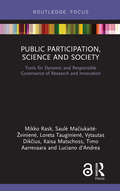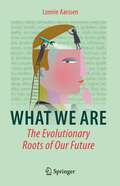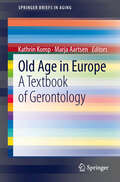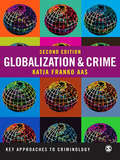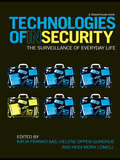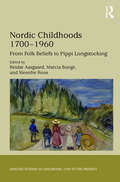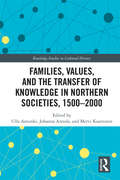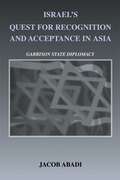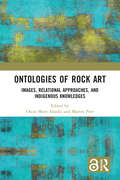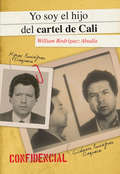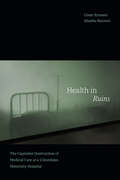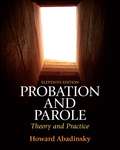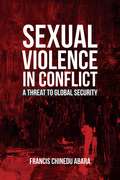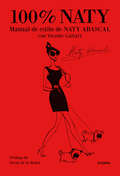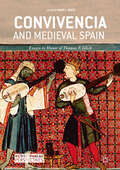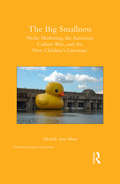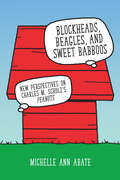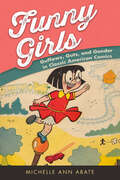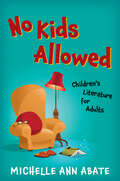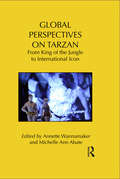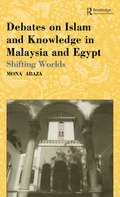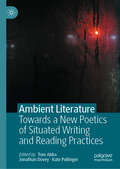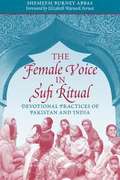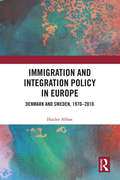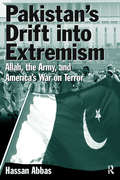- Table View
- List View
Public Participation, Science and Society: Tools for Dynamic and Responsible Governance of Research and Innovation
by Timo Aarrevaara Mikko Rask Saulė Mačiukaitė-Žvinienė Loreta Tauginienė Vytautas Dikčius Kaisa Matschoss Luciano d’AndreaThe field of public participation is developing fast, with phenomena such as citizen science and crowdsourcing extending the resource base of research, stimulating innovation and making science more accessible to the general population. Promoting public participation means giving more weight to citizens and civil society actors in the definition of research needs and in the implementation of research and innovation. As yet, there is limited understanding of the implications of widespread use of public participation and as a result, there is a risk that it will become a burden for research and an obstacle to bridging the gap between research and society. This volume presents the findings of a three-year international study on innovative public participation. The resulting work studies the characteristics and trends of innovative public participation through a global sample of 38 case studies. It provides theoretical generalisations on the dynamics of public participation, suggestions for an evaluation framework and clear empirical examples of how public participation works in practice. Illustrated by best practice cases, the authors identify characteristics which contribute to successful public participation. The book is aimed primarily at scholars and practitioners of public participation, as well as research managers, policy makers and business actors interested in related issues. There is also a secondary market for students and scholars of European governance studies, sociology and political sciences.
What We Are: The Evolutionary Roots of Our Future
by Lonnie AarssenOther animals are driven to spend essentially their whole lives just trying to get fed, stay alive, and get laid. That’s about it. The same was true for our proto-human ancestors. And modern humans of course also require a Survival Drive and a Sex Drive in order to leave descendants. But today we spend most of our lives mainly just trying to convince ourselves that our existence is not absurd. In What We Are, Queen’s University biologist, Lonnie Aarssen, traces how our biocultural evolution has shaped Homo sapiens into the only creature that refuses to be what it is — the only creature preoccupied with a deeply ingrained, and absurd sentiment: I have a distinct ‘mental life’—an ‘inner self’—that exists separately and apart from ‘material life’, and so, unlike the latter, need not come to an end. This delusion conceivably gave our distant ancestors some wishful thinking for finding some measure of relief from the terrifying, uniquely human knowledge of the eventual loss of corporeal survival. But this came with an impulsive, nagging doubt — an obsessive underlying uncertainty: ‘self-impermanence anxiety’. Biocultural evolution, however, was not finished. It also gave us two additional, uniquely human, primal drives, both serving to help quell the burden of this anxiety. Legacy Drive generates delusional cultural domains for ‘extension’ of self; and Leisure Drive generates pleasurable cultural domains for distraction – ‘escape’ – from self. Legacy Drive and Leisure Drive, Aarssen argues, represent two of the most profound consequences of human cognitive and cultural evolution. What We Are advances propositions regarding how a visceral susceptibility to self-impermanence anxiety has — paradoxically — played a pivotal role in rewarding the reproductive success of our ancestors, and has thus been a driving force in shaping fundamental motivations and cultural norms of modern humans. More than any other milestone in the evolution of human minds, self-impermanence anxiety, and its mitigating Drives for Legacy and Leisure, account for not just the advance of civilization over the past many thousands of years, but also now, its impending collapse. Effective management of this crisis, Aarssen insists, will require a deeper and more broadly public understanding of its Darwinian evolutionary roots — as laid out in What We Are.
Old Age In Europe: A Textbook of Gerontology
by Marja Aartsen Kathrin KompEurope currently is the oldest continent in the world and its population is still ageing. This demographic shift affects society, economy, and welfare states. Scholars from various disciplines and the public noted this development and wonder what effects it may have, but lack adequate information. They call for explanations that are concise and easily accessible. The book at hand fills this lacuna. It introduces readers to the most important developments, theories, concepts, and discussions in ageing studies - always keeping an eye on the current situation in Europe. Each chapter adopts the perspective of a different discipline, e.g. public health, sociology, economics, or technology. To make the explanations easy to understand, the book includes learning tools such as learning objectives, multiple choice questions, and a glossary.
Globalization and Crime (Key Approaches to Criminology)
by Katja Franko AasGlobalization & Crime brings together the closely related subjects of criminology and global sociology. Ideal for upper-level undergraduate and postgraduate students, it examines established topics such as human trafficking and smuggling, migration and organised crime. It also delves into new territory and explores the issues surrounding international criminal justice, comparative criminology, green criminology and human rights. New to this Second Edition is a chapter dedicated to the impact that the war on terror has had on the rule of law and a detailed discussion on the growing topic of cosmopolitan criminology. Complete with extensive references, helpful suggestions for further reading and a detailed glossary, this book will prove essential reading for students and academics in criminology, globalization, sociology and other social sciences. The Key Approaches to Criminology series celebrates the removal of traditional barriers between disciplines and, specifically, reflects criminology's interdisciplinary nature and focus. It brings together some of the leading scholars working at the intersections of criminology and related subjects. Each book in the series helps readers to make intellectual connections between criminology and other discourses, and to understand the importance of studying crime and criminal justice within the context of broader debates. The series is intended to have appeal across the entire range of undergraduate and postgraduate studies and beyond, comprising books which offer introductions to the fields as well as advancing ideas and knowledge in their subject areas.
Technologies of InSecurity: The Surveillance of Everyday Life
by Katja Aas Helene Gundhus Heidi LomellTechnologies of Insecurity examines how general social and political concerns about terrorism, crime, migration and globalization are translated into concrete practices of securitisation of everyday life. Who are we afraid of in a globalizing world? How are issues of safety and security constructed and addressed by various local actors and embodied in a variety of surveillance systems? Examining how various forms of contemporary insecurity are translated into, and reduced to, issues of surveillance and social control, this book explores a variety of practical and cultural aspects of technological control, as well as the discourses about safety and security surrounding them. (In)security is a politically and socially constructed phenomenon, with a variety of meanings and modalities. And, exploring the inherent duality and dialectics between our striving for security and the simultaneous production of insecurity, Technologies of Insecurity considers how mundane objects and activities are becoming bearers of risks which need to be neutralised. As ordinary arenas - such as the workplace, the city centre, the football stadium, the airport, and the internet - are imbued with various notions of risk and danger and subject to changing public attitudes and sensibilities, the critical deconstruction of the nexus between everyday surveillance and (in)security pursued here provides important new insights about how broader political issues are translated into concrete and local practices of social control and exclusion.
Nordic Childhoods 1700–1960: From Folk Beliefs to Pippi Longstocking (Studies in Childhood, 1700 to the Present)
by Reidar Aasgaard Marcia Bunge Merethe RoosThis volume strengthens interest and research in the fields of both Childhood Studies and Nordic Studies by exploring conceptions of children and childhood in the Nordic countries (Denmark, Finland, Iceland, Norway, and Sweden). Although some books have been written about the history of childhood in these countries, few are multidisciplinary, focus on this region as a whole, or are available in English. This volume contains essays by scholars from the fields of literature, history, theology, religious studies, intellectual history, cultural studies, Scandinavian studies, education, music, and art history. Contributors study the history of childhood in a wide variety of sources, such as folk and fairy tales, legal codes, religious texts, essays on education, letters, sermons, speeches, hymns, paintings, novels, and school essays written by children themselves. They also examine texts intended specifically for children, including text books, catechisms, newspapers, songbooks, and children’s literature. By bringing together scholars from multiple disciplines who raise distinctive questions about childhood and take into account a wide range of sources, the book offers a fresh and substantive contribution to the history of childhood in the Nordic countries between 1700 and 1960. The volume also helps readers trace the historical roots of the internationally recognized practices and policies regarding child welfare within the Nordic countries today and prompts readers from any country to reflect on their own conceptions of and commitments to children.
Families, Values, and the Transfer of Knowledge in Northern Societies, 1500–2000 (Routledge Studies in Cultural History #66)
by Ulla Aatsinki Johanna Annola Mervi KaarninenThis edited collection sheds light on Nordic families’ strategies and methods for transferring significant cultural heritage to the next generation over centuries. Contributors explore why certain values, attitudes, knowledge, and patterns were selected while others were left behind, and show how these decisions served and secured families’ well-being and values. Covering a time span ranging from the early modern era to the end of the twentieth century, the book combines the innovative "history from below" approach with a broad variety of families and new kinds of source material to open up new perspectives on the history of education and upbringing.
Israel's Quest for Recognition and Acceptance in Asia: Garrison State Diplomacy (Israeli History, Politics and Society #No. 34)
by Jacob AbadiThis title represents a comprehensive study of Israel's attempts to build diplomatic relations with countries on the Asian continent. The author argues that, despite the persistence of the Arab Israeli conflict, the Israeli Foreign Ministry was remarkably successful in gaining recognition in most Asian countries. He provides an overview of Israel's relations with Asian countries from 1948 until the present, and analyses the political, social and economic factors in each country and the role that each played in the process of rapprochement with Israel. He explores the reasons for Israel's successes as well as its failures, and analyses the flaws in Israeli diplomacy.
Ontologies of Rock Art: Images, Relational Approaches, and Indigenous Knowledges
by Oscar Moro Abadía Martin PorrOntologies of Rock Art is the first publication to explore a wide range of ontological approaches to rock art interpretation, constituting the basis for groundbreaking studies on Indigenous knowledges, relational metaphysics, and rock imageries. The book contributes to the growing body of research on the ontology of images by focusing on five main topics: ontology as a theoretical framework; the development of new concepts and methods for an ontological approach to rock art; the examination of the relationships between ontology, images, and Indigenous knowledges; the development of relational models for the analysis of rock images; and the impact of ontological approaches on different rock art traditions across the world. Generating new avenues of research in ontological theory, political ontology, and rock art research, this collection will be relevant to archaeologists, anthropologists, and philosophers. In the context of an increasing interest in Indigenous ontologies, the volume will also be of interest to scholars in Indigenous studies. Chapter 14 of this book is freely available as a downloadable Open Access PDF under a Creative Commons Attribution-Non Commercial-No Derivatives 4.0 license available at https://www.taylorfrancis.com/books/edit/10.4324/9780429321863/ontologies-rock-art-oscar-moro-abad%C3%ADa-martin-porr?context=ubx&refId=3766b051-4754-4339-925c-2a262a505074
Yo soy el hijo del cartel de Cali
by William Rodríguez AbadíaUn testimonio único y estremecedor de uno de los periodos más terribles de la historia de Colombia Yo soy el hijo del cartel de Cali es el testimonio de William Rodríguez Abadía, hijo y sobrino de Miguel y Gilberto Rodríguez Orejuela, fundadores de una de las organizaciones criminales más temidas de Colombia en la década de los noventa. Por primera vez y con un tono íntimo, el heredero de uno de los emporios criminales más grandes de América cuenta cómo se vivió al interior de la familia Rodríguez Orejuela la encarnizada lucha contra Pablo Escobar y el agotamiento de los recursos para lograr impedir las órdenes de extradición que pesaban en su contra. Tras cuatro años de vivir en la clandestinidad y luego cumplir pena de cárcel, el autor pone en riesgo su seguridad y la de su familia para describir en este testimonio revelador, los entresijos del funcionamiento del cartel, la compra de conciencias y la penetraciónde la organización criminal en las más altas esferas de la vida política, económica y social de Colombia. El lector conocerá a una familia dominada por el pacto de silencio del padre y el tío y encontrará respuestas a muchas interrogantes que van desde el vínculo entre el fútbol y el narcotráfico hasta los favores políticos y el Proceso ocho mil.
Health in Ruins: The Capitalist Destruction of Medical Care at a Colombian Maternity Hospital (Experimental Futures)
by César Ernesto Abadía-BarreroIn Health in Ruins César Ernesto Abadía-Barrero chronicles the story of El Materno—Colombia’s oldest maternity and neonatal health center and teaching hospital—over several decades as it faced constant threats of government shutdown. Using team-based and collaborative ethnography to analyze the social life of neoliberal health policy, Abadía-Barrero details the everyday dynamics around teaching, learning, and working in health care before, during, and after privatization. He argues that health care privatization is not only about defunding public hospitals; it also ruins rich traditions of medical care by denying or destroying ways of practicing medicine that challenge Western medicine. Despite radical cuts in funding and a corrupt and malfunctioning privatized system, El Materno’s professors, staff, and students continued to find ways to provide innovative, high-quality, and noncommodified health care. By tracking the violences, conflicts, hopes, and uncertainties that characterized the struggles to keep El Materno open, Abadía-Barrero demonstrates that any study of medical care needs to be embedded in larger political histories.
Probation and Parole: Theory and Practice
by Howard AbadinskyWritten by a former community corrections professional,PROBATION AND PAROLE, 11/e provides an insider's view of probation and parole. Featuring a two-color design, it addresses both juvenile and adult populations and includes authentic reports, forms and narrative from agencies throughout the country. This edition features material on motivational interviewing, restorative justice, community-based supervision, evidence-based practice, offender re-entry, and other state-of-the-art practices. Expanded review questions engage students in material as they examine the controversial issues impacting the system.
Sexual Violence in Conflict: A Threat to Global Security
by Francis Chinedu AbaraThe originality of this book rests in the application of the human security framework to analyze sexual and gender-based violence in conflict. The human security paradigm is concerned and centered on the individual's security threats holistically and is i
100% Naty: Manual de estilo de Naty Abascal con Vicente Gallart
by Naty Abascal Vicente GallartNaty Abascal nos descubre sus secretos para poder vestir con personalidad propia y no morir en el intento. La estilista e icono de la moda a nivel mundial Naty Abascal ha decidido compartir, por primera vez, todos sus conocimientos para proponerte un fascinante viaje por el armario de la mujer actual. A través de él, conocerás cuestiones tan prácticas como qué piezas básicas son imprescindibles y cuáles te sobran, qué accesorios son los más idóneos para el día y cuáles son los que realmente triunfan de noche, cómo es conveniente vestirse a la hora de trabajar o qué debe contener una maleta de viaje perfecta. Este manual también pone los puntos sobre las íes respecto a temas más delicados como la necesaria renovación constante o los errores de estilo más habituales. Junto al periodista de moda Vicente Gallart, Naty Abascal te invita a descubrir los secretos de una moda que lucha contra el aburrimiento sin caer en el ridículo, de una moda que rompe protocolos sin perder un ápice de elegancia, de una moda que te ayude a renovarte tanto por fuera como por dentro.
Convivencia and Medieval Spain: Essays in Honor of Thomas F. Glick (Mediterranean Perspectives)
by Mark T. AbateThis volume is a collection of essays on medieval Spain, written by leading scholars on three continents, that celebrates the career of Thomas F. Glick. Using a wide array of innovative methodological approaches, these essays offer insights on areas of medieval Iberian history that have been of particular interest to Glick: irrigation, the history of science, and cross-cultural interactions between Jews, Christians, and Muslims. By bringing together original research on topics ranging from water management and timekeeping to poetry and women’s history, this volume crosses disciplinary boundaries and reflects the wide-ranging, gap-bridging work of Glick himself, a pivotal figure in the historiography of medieval Spain.
The Big Smallness: Niche Marketing, the American Culture Wars, and the New Children’s Literature (Children's Literature and Culture)
by Michelle Ann AbateThis book is the first full-length critical study to explore the rapidly growing cadre of amateur-authored, independently-published, and niche-market picture books that have been released during the opening decades of the twenty-first century. Emerging from a powerful combination of the ease and affordability of desktop publishing software; the promotional, marketing, and distribution possibilities allowed by the Internet; and the tremendous national divisiveness over contentious socio-political issues, these texts embody a shift in how narratives for young people are being creatively conceived, materially constructed, and socially consumed in the United States. Abate explores how titles such as My Parents Open Carry (about gun laws), It’s Just a Plant (about marijuana policy), and My Beautiful Mommy (about the plastic surgery industry) occupy important battle stations in ongoing partisan conflicts, while they are simultaneously changing the landscape of American children’s literature. The book demonstrates how texts like Little Zizi and Me Tarzan, You Jane mark the advent of not simply a new commercial strategy in texts for young readers; they embody a paradigm shift in the way that narratives are being conceived, constructed, and consumed. Niche market picture books can be seen as a telling barometer about public perceptions concerning children and the social construction of childhood, as well as the function of narratives for young readers in the twenty-first century. At the same time, these texts reveal compelling new insights about the complex interaction among American print culture, children’s reading practices, and consumer capitalism. Amateur-authored, self-published, and specialty-subject titles reveal the way in which children, childhood, and children’s literature are both highly political and heavily politicized in the United States. The book will be of interest to scholars and students in the fields of American Studies, children’s literature, childhood studies, popular culture, political science, microeconomics, psychology, advertising, book history, education, and gender studies.
Blockheads, Beagles, and Sweet Babboos: New Perspectives on Charles M. Schulz's Peanuts
by Michelle Ann AbateBlockheads, Beagles, and Sweet Babboos: New Perspectives on Charles M. Schulz's "Peanuts" sheds new light on the past importance, ongoing significance, and future relevance of a comics series that millions adore: Charles M. Schulz’s Peanuts. More specifically, it examines a fundamental feature of the series: its core cast of characters. In chapters devoted to Charlie Brown, Snoopy, Lucy, Franklin, Pigpen, Woodstock, and Linus, author Michelle Ann Abate explores the figures who made Schulz’s strip so successful, so influential, and—above all—so beloved. In so doing, the book gives these iconic figures the in-depth critical attention that they deserve and for which they are long overdue. Abate considers the exceedingly familiar characters from Peanuts in markedly unfamiliar ways. Drawing on a wide array of interpretive lenses, Blockheads, Beagles, and Sweet Babboos invites readers to revisit, reexamine, and rethink characters that have been household names for generations. Through this process, the chapters demonstrate not only how Schulz’s work remains a subject of acute critical interest more than twenty years after the final strip appeared, but also how it embodies a rich and fertile site of social, cultural, and political meaning.
Funny Girls: Guffaws, Guts, and Gender in Classic American Comics
by Michelle Ann AbateFor several generations, comics were regarded as a boys’ club—created by, for, and about men and boys. In the twenty-first century, however, comics have seen a rise of female creators, characters, and readers. While this sudden presence of women and girls in comics is being regarded as new and noteworthy, the observation is not true for the genre’s entire history. Throughout the first half of the twentieth century, the medium was enjoyed equally by both sexes, and girls were the protagonists of some of the earliest, most successful, and most influential comics. In Funny Girls: Guffaws, Guts, and Gender in Classic American Comics, Michelle Ann Abate examines the important but long-overlooked cadre of young female protagonists in US comics during the first half of the twentieth century. She treats characters ranging from Little Orphan Annie and Nancy to Little Lulu, Little Audrey of the Harvey Girls, and Li’l Tomboy—a group that collectively forms a tradition of Funny Girls in American comics. Abate demonstrates the massive popularity these Funny Girls enjoyed, revealing their unexplored narrative richness, aesthetic complexity, and critical possibility. Much of the humor in these comics arose from questioning gender roles, challenging social manners, and defying the status quo. Further, they embodied powerful points of collection about both the construction and intersection of race, class, gender, and age, as well as popular perceptions about children, representations of girlhood, and changing attitudes regarding youth. Finally, but just as importantly, these strips shed light on another major phenomenon within comics: branding, licensing, and merchandising. Collectively, these comics did far more than provide amusement—they were serious agents for cultural commentary and sociopolitical change.
No Kids Allowed: Children's Literature for Adults
by Michelle Ann AbateChildren's literature isn't just for children anymore. This original study explores the varied forms and roles of children's literature—when it's written for adults.What do Adam Mansbach's Go the F**k to Sleep and Barbara Park's MA! There's Nothing to Do Here! have in common? These large-format picture books are decidedly intended for parents rather than children. In No Kids Allowed, Michelle Ann Abate examines a constellation of books that form a paradoxical new genre: children's literature for adults. Distinguishing these books from YA and middle-grade fiction that appeals to adult readers, Abate argues that there is something unique about this phenomenon. Principally defined by its form and audience, children's literature, Abate demonstrates, engages with more than mere nostalgia when recast for grown-up readers. Abate examines how board books, coloring books, bedtime stories, and series detective fiction written and published specifically for adults question the boundaries of genre and challenge the assumption that adulthood and childhood are mutually exclusive.
Global Perspectives on Tarzan: From King of the Jungle to International Icon (Routledge Research in Cultural and Media Studies)
by Michelle Ann Abate Annette WannamakerThis collection seeks to understand the long-lasting and global appeal of Tarzan: Why is a story about a feral boy, who is raised by apes in the African jungle, so compelling and so adaptable to different cultural contexts and audiences? How is it that the same narrative serves as the basis for both children’s cartoons and lavish musical productions or as a vehicle for both nationalistic discourse and for light romantic fantasy? Considering a history of criticism that highlights the imperialistic, sexist, racist underpinnings of the original Tarzan narrative, why would this character and story appeal to so many readers and viewers around the world? The essays in this volume, written by scholars living and working in Australia, Canada, Israel, The Netherlands, Germany, France and the United States explore these questions using various critical lenses. Chapters include discussions of Tarzan novels, comics, television shows, toys, films, and performances produced or distributed in the U.S., Canada, Israel, Palestine, Britain, India, The Netherlands, Germany and France and consider such topics as imperialism, national identities, language acquisition, adaptation, gender constructions, Tarzan’s influence on child readers and Tarzan’s continued and broad influence on cultures around the world. What emerges, when these pieces are placed into dialogue with one another, is an immensely complex picture of an enduring, multi-faceted global pop culture icon.
Debates on Islam and Knowledge in Malaysia and Egypt: Shifting Worlds
by Mona AbazaThis book is a comparative study of the sociological field in two different Muslim societies: Malaysia and Egypt. It analyses the process of the production of 'knowledge' through the example of the modern 'Islamization of knowledge debate' and local empirical variations.
Ambient Literature: Towards a New Poetics of Situated Writing and Reading Practices
by Tom Abba Jonathan Dovey Kate PullingerThis book considers how a combination of place-based writing and location responsive technologies produce new kinds of literary experiences. Building on the work done in the Ambient Literature Project (2016–2018), this books argues that these encounters constitute new literary forms, in which the authored text lies at the heart of an embodied and mediated experience. The visual, sonic, social and historic resources of place become the elements of a live and emergent mise-en-scène. Specific techniques of narration, including hallucination, memory, history, place based writing, and drama, as well as reworking of traditional storytelling forms combine with the work of app and user experience design, interaction, software authoring, and GIS (geographical information systems) to produce ambient experiences where the user reads a textual and sonic literary space. These experiences are temporary, ambiguous, and unpredictable in their meaning but unlike the theatre, the gallery, or the cinema they take place in the everyday shared world. The book explores the potentiality of a new literary form produced by the exchange between location-aware cultural objects, writers and readers. This book, and the work it explores, lays the ground for a new poetics of situated writing and reading practices.
The Female Voice in Sufi Ritual: Devotional Practices of Pakistan and India
by Abbas Shemeem BurneyThe female voice plays a more central role in Sufi ritual, especially in the singing of devotional poetry, than in almost any other area of Muslim culture. This research clarifies why the female voice is so important in Sufi practice and underscores the many contributions of women to Sufism and its rituals.
Immigration and Integration Policy in Europe: Denmark and Sweden, 1970–2010
by Haider AbbasThis book analyzes contemporary changes in immigration and integration policy in the wake of populism and rise of right-wing parties across the world. It examines how, in the face of substantial migratory flows, rising security concerns regarding immigration, and a refugee crisis of unprecedented levels, member states of the European Union have responded by calling for restrictive immigration policies, border patrolling, and intensified integration programs. Focusing on Denmark and Sweden, the volume employs a unified theoretical framework to look at how internal political debates, institutional patterns, constitutional frameworks, and political competition are key to a systematic explanation of immigration and integration policy changes in Europe. This volume will be of great interest to scholars and researchers of migration and diaspora studies, public policy, politics and international relations, sociology, and social anthropology, as well as government officials, think tanks, and policymakers.
Pakistan's Drift into Extremism: Allah, the Army, and America's War on Terror
by Hassan AbbasThis book examines the rise of religious extremism in Pakistan, particularly since 1947, and analyzes its connections to the Pakistani army's corporate interests and U.S.-Pakistan relations. It includes profiles of leading Pakistani militant groups with details of their origins, development, and capabilities. The author begins with an historical overview of the introduction of Islam to the Indian sub-continent in 712 AD, and brings the story up to the present by describing President Musharraf's handling of the war on terror. He provides a detailed account of the political developments in Pakistan since 1947 with a focus on the influence of religious and military forces. He also discusses regional politics, Pakistan's attempt to gain nuclear power status, and U.S.-Pakistan relations, and offers predictions for Pakistan's domestic and regional prospects.
